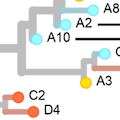Abstract
Helicobacter pylori chronically infects the stomach of approximately half of the world’s population. Manifestation of clinical diseases associated with H. pylori infection, including cancer, is driven by strain properties and host responses; and as chronic infection persists, both are subject to change. Previous studies have documented frequent and extensive within-host bacterial genetic variation. To define how within-host diversity contributes to phenotypes related to H. pylori pathogenesis, this project leverages a collection of 39 clinical isolates acquired prospectively from a single subject at two time points and from multiple gastric sites. During the six years separating collection of these isolates, this individual, initially harboring a duodenal ulcer, progressed to gastric atrophy and concomitant loss of acid secretion. Whole genome sequence analysis identified 1,767 unique single nucleotide polymorphisms (SNPs) across isolates and a nucleotide substitution rate of 1.3×10-4 substitutions/site/year. Gene ontology analysis identified cell envelope genes among the genes with excess accumulation of nonsynonymous SNPs (nSNPs). A maximum likelihood tree based on genetic similarity clusters isolates from each time point separately. Within time points, there is segregation of subgroups with phenotypic differences in bacterial morphology, ability to induce inflammatory cytokines, and mouse colonization. Higher inflammatory cytokine induction in recent isolates maps to shared polymorphisms in the Cag PAI protein, CagY, while rod morphology in a subgroup of recent isolates mapped to eight mutations in three distinct helical cell shape determining (csd) genes. The presence of subgroups with unique genetic and phenotypic properties suggest complex selective forces and multiple niches within the stomach during chronic infection.
